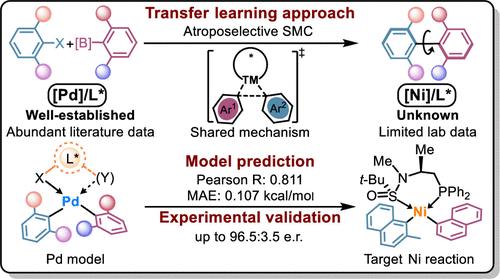基于机制相似性的镍催化atroopselective Suzuki-Miyaura交叉偶联的迁移学习支持配体预测:利用Pd知识发现Ni
IF 15.6
1区 化学
Q1 CHEMISTRY, MULTIDISCIPLINARY
引用次数: 0
摘要
新型分子催化剂由于其复杂的结构-性能关系,往往面临着合理设计的挑战。新兴的数据驱动方法提供了革命性的解决方案,但机器学习在新催化剂开发中的应用不可避免地面临低数据体系和有限的有效结构性能建模。在这项研究中,我们提出了一种迁移学习策略,以促进知识从已有文献记载的Pd催化转移到一个新的,尚未开发的Ni系统。通过对广泛的Pd催化数据和有限的Ni/Sadphos数据进行协同建模,我们的方法准确地预测了新的Sadphos配体,实现了第一个atroopselective Ni催化的Suzuki-Miyaura交叉偶联反应。该机器学习预测配体具有广泛的合成范围和克级合成能力,并能在Ni和Pd催化下通过序贯偶联精确控制对萘的双轴手性,进一步证明了该配体的合成实用性。此外,利用密度泛函理论计算揭示了这种新型Ni催化剂的反应机理和立体化学模型,验证了Ni和Pd之间的机理联系。这项工作展示了机器学习模型如何有效地利用机制连通性,应用文献中广泛的结构-性能关系数据来预测新的催化剂,从几次学习的角度为分子催化剂的合理设计提供了一种新的策略。本文章由计算机程序翻译,如有差异,请以英文原文为准。

Transfer Learning-Enabled Ligand Prediction for Ni-Catalyzed Atroposelective Suzuki–Miyaura Cross-Coupling Based on Mechanistic Similarity: Leveraging Pd Knowledge for Ni Discovery
The rational design of novel molecular catalysts often confronts challenges due to complex structure–performance relationships. Emerging data-driven approaches provide revolutionary solutions, yet the application of machine learning to new catalyst development inevitably faces a low-data regime with limited effective structure–performance modelings available. In this study, we present a transfer learning strategy to facilitate knowledge transfer from well-documented Pd catalysis to a novel, underexplored Ni system. By synergistically modeling extensive Pd catalysis data with limited Ni/Sadphos data, our approach accurately predicted novel Sadphos ligands, enabling the first atroposelective Ni-catalyzed Suzuki–Miyaura cross-coupling reaction. The synthetic utility of the machine learning-predicted ligand was further demonstrated in its broad synthetic scope, gram-scale synthesis, and precise control of dual axial chiralities in ternaphthalene through the sequential coupling under Ni and Pd catalysis. Additionally, density functional theory calculations were employed to reveal the reaction mechanism and stereochemical model of this new Ni catalyst, validating the proposed mechanistic connection between Ni and Pd. This work demonstrates how machine learning models can effectively leverage mechanistic connectivity, applying extensive structure–performance relationship data from the literature to predict new catalysts, providing a novel strategy for the rational design of molecular catalysts from a few-shot learning perspective.
求助全文
通过发布文献求助,成功后即可免费获取论文全文。
去求助
来源期刊
CiteScore
24.40
自引率
6.00%
发文量
2398
审稿时长
1.6 months
期刊介绍:
The flagship journal of the American Chemical Society, known as the Journal of the American Chemical Society (JACS), has been a prestigious publication since its establishment in 1879. It holds a preeminent position in the field of chemistry and related interdisciplinary sciences. JACS is committed to disseminating cutting-edge research papers, covering a wide range of topics, and encompasses approximately 19,000 pages of Articles, Communications, and Perspectives annually. With a weekly publication frequency, JACS plays a vital role in advancing the field of chemistry by providing essential research.

 求助内容:
求助内容: 应助结果提醒方式:
应助结果提醒方式:


